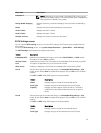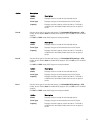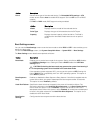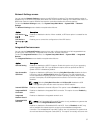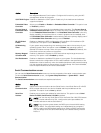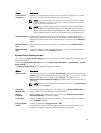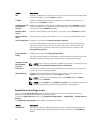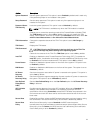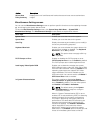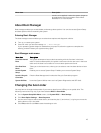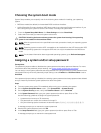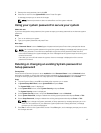
Option Description
System Password Sets the system password. This option is set to Enabled by default and is read-only
if the password jumper is not installed in the system.
Setup Password Sets the setup password. This option is read-only if the password jumper is not
installed in the system.
Password Status Locks the system password. This option is set to Unlocked by default.
TPM Security
NOTE: The TPM menu is available only when the TPM module is installed.
Enables you to control the reporting mode of the Trusted Platform Module (TPM).
The TPM Security option is set to Off by default. You can only modify the TPM
Status, TPM Activation, and Intel TXT fields if the TPM Status field is set to either On
with Pre-boot Measurements or On without Pre-boot Measurements.
TPM Information Changes the operational state of the TPM. This option is set to No Change by
default.
TPM Status Displays the TPM status.
TPM Command
CAUTION: Clearing the TPM results in the loss of all keys in the TPM. The
loss of TPM keys may affect booting to the operating system.
Clears all the contents of the TPM. The TPM Clear option is set to No by default.
Intel TXT Enables or disables the Intel Trusted Execution Technology (TXT). To enable the
Intel TXT option, virtualization technology must be enabled and TPM Security must
be Enabled with Pre-boot measurements. This option is set to Off by default.
Power Button Enables or disables the power button on the front of the system. This option is set
to Enabled by default.
NMI Button Enables or disables the NMI button on the front of the system. This option is set to
Disabled by default.
AC Power
Recovery
Sets how the system reacts after AC power is restored to the system. This option is
set to Last by default.
AC Power
Recovery Delay
Sets how the system supports staggering of power up after AC power is restored to
the system. This option is set to Immediate by default.
User Defined
Delay (60s to
240s)
Sets the User Defined Delay when the User Defined option for AC Power Recovery
Delay is selected.
UEFI Variable
Access
Provides varying degrees of securing UEFI variables. When set to Standard (the
default), UEFI variables are accessible in the operating system per the UEFI
specification. When set to Controlled, selected UEFI variables are protected in the
environment and new UEFI boot entries are forced to be at the end of the current
boot order.
Secure Boot Enables Secure Boot, where the BIOS authenticates each pre-boot image by using
the certificates in the Secure Boot Policy. Secure Boot is disabled by default.
Secure Boot
Policy
When Secure Boot policy is set to Standard, the BIOS uses the system
manufacturer’s key and certificates to authenticate pre-boot images. When Secure
Boot policy is set to Custom, the BIOS uses the user-defined key and certificates.
Secure Boot policy is set to Standard by default.
41



